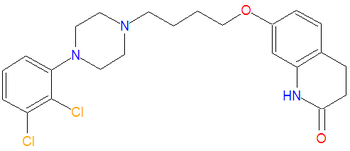Aripiprazole: Difference between revisions
imported>David E. Volk m (fix link) |
imported>David E. Volk (Chemical structure and chem infobox) |
||
| Line 1: | Line 1: | ||
{{subpages}} | {{subpages}} | ||
{{Chem infobox | |||
|align=right | |||
|image=[[Image:Aripiprazole.png|center|thumb|350px]] | |||
|width=350px | |||
|molname=Aripiprazole | |||
|synonyms= | |||
|molformula= C<sub>23</sub>H<sub>27</sub>Cl<sub>2</sub>N<sub>3</sub>O<sub>2</sub> | |||
|molmass= 448.38 | |||
|uses=[[antipsychotic agent]] | |||
|properties=medication | |||
|hazards=see side effects & drug interactions | |||
|iupac= 7-[4-[4-(2,3-dichlorophenyl)-1-piperazinyl]butoxy]-3,4-dihydrocarbostyril | |||
|casnumber= | |||
}} | |||
In [[medicine]], '''aripiprazole''' (pronunciation: ay ri pip' ray zole) is an atypical or second generation [[antipsychotic agent]] that "has both presynaptic [[dopamine]] autoreceptor agonistic activity and postsynaptic D<sub>2</sub> receptor antagonistic activity; structure given in first source; use associated with hyperglycemia."<ref>{{MeSH}}</ref> | In [[medicine]], '''aripiprazole''' (pronunciation: ay ri pip' ray zole) is an atypical or second generation [[antipsychotic agent]] that "has both presynaptic [[dopamine]] autoreceptor agonistic activity and postsynaptic D<sub>2</sub> receptor antagonistic activity; structure given in first source; use associated with hyperglycemia."<ref>{{MeSH}}</ref> | ||
Revision as of 11:05, 22 May 2011
|
| |||||||
| Aripiprazole | |||||||
| |||||||
| Uses: | antipsychotic agent | ||||||
| Properties: | medication | ||||||
| Hazards: | see side effects & drug interactions | ||||||
| |||||||
In medicine, aripiprazole (pronunciation: ay ri pip' ray zole) is an atypical or second generation antipsychotic agent that "has both presynaptic dopamine autoreceptor agonistic activity and postsynaptic D2 receptor antagonistic activity; structure given in first source; use associated with hyperglycemia."[1]
In the United States, the Food and Drug Administration has approved the use of aripiprazole for the treatment of schizophrenia, bipolar I disorder, major depressive disorder, irritability associated with autistic disorder agitation associated with schizophrenia or mania from bipolar disorder. It is also approved as an adjunct to antidepressants.[2] The trade name is Abilify™. Although not approved for the treatment of dementia, aripiprazole has been studied in this setting.
References
- ↑ Anonymous (2025), Aripiprazole (English). Medical Subject Headings. U.S. National Library of Medicine.
- ↑ Marianna Mazza, Maria Rosaria Squillacioti1, Riccardo Daniele Pecora, Luigi Janiri1 & Pietro Bria (December 2008), "Beneficial acute antidepressant effects of aripiprazole as an adjunctive treatment or monotherapy in bipolar patients unresponsive to mood stabilizers: results from a 16-week open-label trial", Expert Opinion on Pharmacotherapy 9 (18): 3145-3149, DOI:10.1517/14656560802504490
